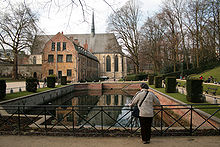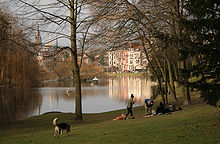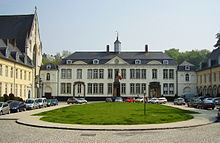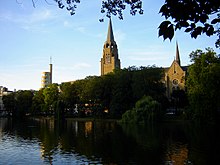Ixelles / Elsene
| Ixelles Elsene |
||
|---|---|---|

|

|
|
|
|
||
| State : |
|
|
| Region : | Brussels capital | |
| Province : | ("de-provincialized" since January 1st, 1995) | |
| District : | Brussels capital | |
| Coordinates : | 50 ° 50 ′ N , 4 ° 22 ′ E | |
| Area : | 6.34 km² | |
| Residents: | 86,876 (Jan 1, 2019) | |
| Population density: | 13,703 inhabitants per km² | |
| Post Code: | 1050 | |
| Prefix: | 02 | |
| Mayor: | Dominique Dufourny ( MR ) | |
Local government address : |
Commune d'Ixelles Chaussée d'Ixelles 168 1050 Bruxelles Gemeente Elsene Elsensesteenweg 168 1050 Brussel |
|
| Website: |
www.ixelles.be www.elsene.be |
|
Ixelles [ iksɛl ] ( French ) or Elsene [ ˈɛlsənə ] ( Dutch ) is one of 19 municipalities in the bilingual Brussels-Capital Region in Belgium . It has 86,876 inhabitants (as of January 1, 2019) on 6.34 square kilometers. Ixelles / Elsene is located in the southeast of Brussels city center and borders the city of Brussels and the municipalities of Etterbeek , Auderghem / Oudergem , Watermael-Boitsfort / Watermaal-Bosvoorde , Uccle / Ukkel and Saint-Gilles / Sint-Gillis . The municipality is divided into two parts because the avenue Louise / Louizalaan , which runs right through Ixelles / Elsene, belongs to the city of Brussels.

history

The original village of Ixelles was located by the ponds in the Maelbeek valley , roughly at the level of today's Place Flagey / Flageyplein. Many alder trees grew there , which were included in the place names and can also be found in the coat of arms. The name is a combination of else = alder and sele = settlement, seat (as in the word Brussels ). This resulted in Elsen in Dutch , later Elsene, in French Isselles and with the double S ligature (as well as in the words Auxerre , Bruxelles and Texel ) Ixel, then Ixelles, which is now pronounced [ iksɛl ] ( French ) due to ignorance of the original spelling becomes.
The building of Louisenallee lined with chestnut trees was commissioned in 1847. The avenue was to become the boulevard of Brussels, which could compete with the boulevard Haussmann in Paris . There was initially strong resistance from Ixelles / Elsene to the project. Since the avenue was to be used by the king as the only access route to the city forest (Bois de la Cambre / Ter Kamerenbos) and all negotiations with the municipality of Ixelles / Elsene remained fruitless, the narrow strip was annexed by the municipality of Brussels in 1864 and thus the resistance of the municipality Ixelles / Elsene bypassed. The annexation resulted in a geographical division of the municipality of Ixelles / Elsene.
local community
As a very contrasting community, Ixelles / Elsene includes busy quarters in the area of the Namener Tor (Porte de Namur / Naamsepoort), green areas near the Bois de la Cambre / Ter Kamerenbos urban forest, luxury quarters , but also problem areas. With its numerous theaters and cinemas, the municipality has established itself as a center of Brussels' cultural and nightlife. Worth seeing are the Elsener pond promenades Les Étangs d'Ixelles / Vijvers van Elsene, the adjoining Art Nouveau residential areas and the Abbey de la Cambre / ter Kameren, whose urban forest Le Bois de la Cambre / Ter Kamerenbos is located in the Brussels city area. The independent universities Vrije Universiteit Brussel (VUB) and Université libre de Bruxelles (ULB) are located in Ixelles / Elsene . The Leopoldsviertel and the Brussels-Luxembourg train station partly belong to Ixelles / Elsene, as do some of the European Parliament buildings right behind the train station . Due to its proximity to the European institutions, Ixelles / Elsene has become a popular residential area for young employees and interns from institutions and associations.
Special neighborhoods
The African-looking Matongé district around the Namener Stadttor is known for its multicultural charm, which originated in the Maison Africaine, the former student residence for Congolese students. In the evening, the African nightlife unfolds especially in the Rue de la Longue Vie / Lang Levenstraat . In the early 2000s, Matongé temporarily fell into disrepute due to riots and crime as a problem area. Southwest of Matongé is the luxury quarter around Louisenallee, part of the Brussels city area, which invites you to stroll and shop. The boulevards at Meeussquare and at Froidurepark are also ideal for strolling. The Boondaelviertel, located between the two university campuses of the Université Libre de Bruxelles and the Vrije Universiteit Brussel, is a trendy student district and is just as lively as the multicultural Flagey district, which is to be upgraded with the current renovation of its central Eugène Flagey square. In the rather bourgeois Kastanienviertel (at Place du Châtelain / Kasteleinsplein ) you will find an above-average number of upscale restaurants, organic food stores, libraries and art shops.
traffic
Tram lines 7, 8, 25, 81 and 92 go through Ixelles / Elsene.In addition to the Brussels-Luxembourg train station , the Etterbeek, Boondael / Boondaal and Germoir / Mouterij stations of the National Society of Belgian Railways (SNCB / NMBS) are also located in the municipality.
Attractions
- Art Nouveau buildings in the border area between Ixelles, Saint-Gilles and the Avenue Louise belonging to the Brussels city area:
- Hôtel Solvay (architect: Victor Horta ; UNESCO World Heritage Site; → location )
- Hôtel Tassel (Victor Horta; UNESCO World Heritage Site; → Location )
- Maison Hankar (71 Rue Defacqz, architect: Paul Hankar; → location )
- Hôtel Ciamberlani (48 Rue Defacqz, architect: Paul Hankar; → location )
- Art Nouveau buildings on the west side of the lakes Étangs d'Ixelles :
- 38 Avenue du Général de Gaulle ( → Location )
- Maison by Léon Delune (6 Rue de Lac; → Location )
- 42-46 Rue Bellevue (architect: Ernest Blerot; → location )
- 30 and 32 Rue Bellevue ( → Location )
- 9 and 11 Rue Vilain XIV (architect: Ernest Blerot; → location )
- Art Deco buildings on Place de Etoile: Palais de la Folle Chanson and Brussels' first skyscraper Résidence de la Cambre ( → location )
- the Abbey de la Cambre ( → Lage )
- the town hall ( → location )
- the church of St-Boniface ( → Lage )
- The Center culturel Flagey on Place Eugène Flagey / Eugène Flageyplein , built in 1930 in the Art Deco style up to the Bauhaus , which gained fame under its former name "Maison de la Radio", was renovated in 2002 and has since been home to several cultural and media centers ( → location ).
- the Université Libre de Bruxelles (university with historical buildings; → location )
- Art Nouveau villa in the residential area ( → location )
- The 5 hectare municipal cemetery is considered one of the most important Belgian cemeteries in terms of the personalities buried there. The Belgian architect Victor Horta is buried there among many others ( → Lage ).
Museums:
- Elsener Museum (Musée d'Ixelles / Museum van Elsene)
- Constantin Meunier Museum
- Antoine Wiertz Museum
- former aquarium and fish farming museum
Sons and daughters of the church
- Joseph-Maurice Exelmans (1816–1875), French admiral
- Pierre Schyven (1827–1906), organ builder
- Jules de Burlet (1844-1897), Prime Minister
- Camille Lemonnier (1844–1913), narrator of naturalism
- Marguerite Poradowska (1848–1937), writer
- Louis Napoléon Chaltin (1857–1933), colonial officer
- Willem Delsaux (1862–1945), painter and graphic artist
- Jules Renkin (1862–1934), politician and prime minister
- Paul Hymans (1865–1941), politician and minister
- Herman Richir (1866–1942), genre, nude and portrait painter and art educator
- Frédéric Swarts (1866–1940), chemist
- Émile Vandervelde (1866–1938), social democrat, university professor, politician and chairman of the Second International
- Paul Spaak (1871–1936), lawyer and writer
- Marie Depage (1872–1915), diplomat
- Henri Meunier (1873–1922), painter, graphic artist, illustrator and poster artist
- Auguste Perret (1874–1954), architect
- Charles Van den Borren (1874–1966), musicologist
- Henri Schouteden (1881–1972), entomologist, ornithologist and zoologist
- Frans Van Holder (1881–1919), painter
- Arthur Duray (1882–1954), racing car driver
- Félix Goblet d'Alviella (1884–1957), fencer, lawyer, sports official and journalist
- Jacques Feyder (1885–1948), Franco-Belgian film director
- Ernest Vander Linden (1886–1974), banker and the first private banker in Luxembourg
- Félicien Courbet (1888–1967), water polo player and swimmer
- Louis Clesse (1889–1961), painter
- Marie Delcourt (1891–1979), classical philologist and ancient historian
- Charles Delporte (1893-1960), fencer
- Jane Graverol (1897–1984), painter of surrealism
- Michel de Ghelderode (1898–1962), playwright, journalist and prose writer
- Marc Somerhausen (1899–1992), lawyer and politician with the Belgian Workers' Party
- Édouard Écuyer de le Court (1901–1951), modern pentathlon
- Charles de Cumont (1902–1990), Lieutenant General
- Albert Crahay (1903–1991), Lieutenant General and Commander in Chief of the Belgian Armed Forces in Germany
- Léon-Joseph Suenens (1904–1996), Archbishop of Mechlin-Brussels
- Fernand Gravey (1905–1970), actor
- Marc Fernand Severin (1906–1987), bookplate artist
- Rosa Bouglione , b. Rosalie Van Been (1910-2018), French circus performer
- Robert Maistriau (1921–2008), resistance fighter
- Gilbert Stork (1921–2017), American chemist
- André Lagasse (1923-2010), lawyer, university professor and politician (FDF)
- Michel Boudart (1924–2012), Belgian-American chemist and chemical engineer
- François Rigaux (1926–2013), lawyer
- René Thomas (1928–2017), molecular biologist
- Agnès Varda (1928–2019), French photographer and filmmaker
- Alfred Cahen (1929–2000), diplomat, Secretary General of the Western European Union and Ambassador to France
- Audrey Hepburn (1929-1993), actress
- Liliane Wouters (1930–2016), writer
- Michel Régnier alias Greg (1931–1999), comic artist
- Eddie Defacq (1933–2013), jazz musician and chansonnier
- Alec Severin (* 1963), comic artist
- Francis Buekenhout (born 1937), mathematician
- Pol Closset (1937-1989), jazz musician
- Antoine Duquesne (1941-2010), politician
- Benoît Cardon de Lichtbuer (* 1942), ambassador
- Marc Moulin (1942–2008), jazz and fusion musician, author
- Annemie Neyts-Uyttebroeck (* 1944), politician, MEP
- Christian Denayer (* 1945), comic artist
- Boris Szulzinger (* 1945), film director and producer
- Paul Jorion (* 1946), anthropologist and business columnist
- Pierre Blacks (born 1948), archer
- Pierre Rapsat (1948–2002), singer
- John Vink (* 1948), photographer and member of the Magnum photo agency
- Jean-Luc Differdange (* 1951), Belgian-Luxembourg photographer and singer-songwriter
- Charles Ghislain (* 1951), diplomat
- Paul Fontaine (* 1954), classical archaeologist
- Marc Dutroux (* 1956), serial killer and sex offender
- Alain Goffin (* 1956), comic artist
- Frank Pé (* 1956), comic artist
- Jaco Van Dormael (* 1957), author and director for film and theater
- Ursula von der Leyen (* 1958), EU Commission President
- Maurane (1960–2018), chanson singer
- Jean-François van Boxmeer (* 1961), manager
- Olivier Minne (* 1967), French entertainer and television quiz master
- Miriam Cnop (* 1970), medical doctor
- Maureen Dor (* 1970), television presenter and actress
- Muriel Houtteman or "Fili Houteman" (* 1972), striptease dancer, significantly involved in the Monegasque affair Ducruet
- Natacha Régnier (* 1972), actress and singer
- Cédric Taymans (* 1975), judoka
- Sophie Wilmès (* 1975), politician and Prime Minister
- Kris Bosmans (* 1980), cyclist
- Pauline Étienne (* 1989), actress
- Yannick Carrasco (* 1993), soccer player
- Frank Ntilikina (* 1998), French basketball player
Web links
- Website of the municipality of Ixelles / Elsene (Dutch, French)
Individual evidence
- ↑ Histoire des environs de Bruxelles ou description historique des localités qui formaient autrefois l'ammannie de cette ville , Tome troisième, Alphonse Guillaume G. Wauters. C. Vanderauwera, Bruxelles, 1855.
- ^ Roan van Eyck: Gemeente Elsene: Rijk en arm verzoenen Bruzz of September 20, 2017, pages 20-22, online









